Leopard geckos are skittish and shy reptiles that require a calm, stable environment. The best substrate for leopard gecko is one that provides them with the ability to burrow into it while also providing enough space for their food and water dishes.
In this article, we will discuss what makes a good substrate for leopard geckos as well as dangers of bad substrates to avoid. The main point of note is to avoid substrates that may be swallowed by the geckos as this may cause impaction and death in some cases.
What makes a great Leopard gecko substrate?
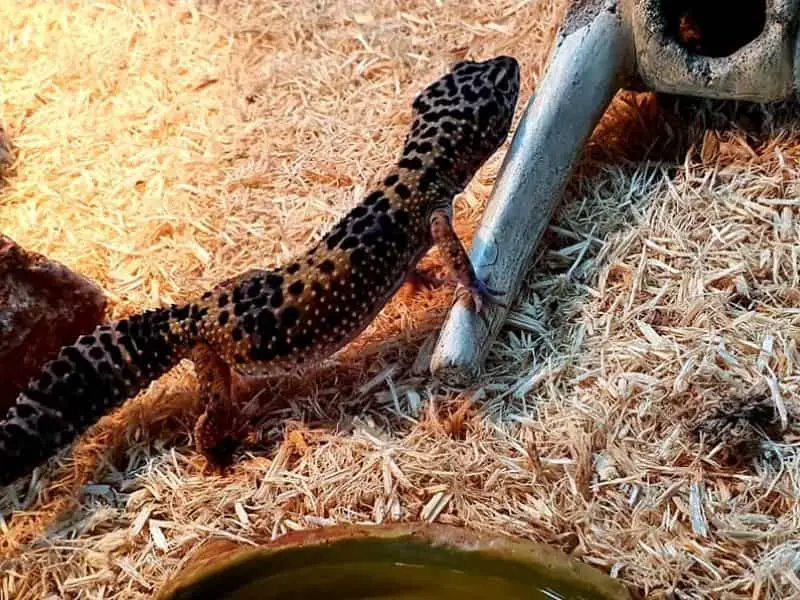
Your leopard geckos walk and lay eggs on their substrates. They also eat food from the substrates as well with the substrate catching their wastes. As such, the best substrate needs to have the following features:
- Safe for the geckos to eat off it.
- Safe for the geckos to lay eggs on it.
- Soft enough not to hurt the geckos.
- Easy to clean to keep the cage clean and safe.
- It should not collect dust at a high rate since dust irritates the leopard geckos.
- It should not be irritating to the leopard geckos in any way whether it’s through contact or inhalation.
With these aspects in mind, let’s take a look at what the best leopard gecko bedding is.
What is the best substrate for leopard geckos?
The best floorings for leopard geckos include the following:
1. Zoo Med Reptisand Natural Terrarium Sand
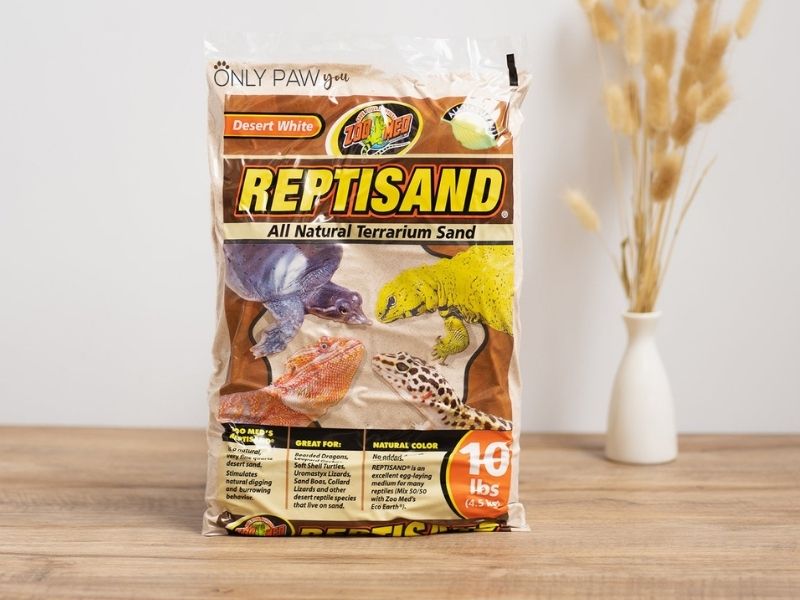
First up is the Zoo Med Reptisand Natural Terrarium Sand. This sand is made from dust-free quartz so it’s safe for the geckos to eat off of and lay eggs on. It’s also a great substrate because it can be used with or without heat lamps, which means it’s perfect for leopard geckos that live in different climates.
Zoo Med ReptiSand has two other big advantages one of which is that it doesn’t pick up too much dirt like some substrates do (which makes cleaning easier).
The other advantage is that the grains are large enough that insects don’t burrow into the bedding as they do with finer sands. As such, your gecko will be more comfortable since there won’t be any creepy crawlers crawling across their skins.
The good
- It’s a leopard gecko natural substrate which means it simulates the natural quality of the substrates in the wild.
- No dyes or paints added which may be dangerous for the leopard gecko.
- Can also be used with other pets such as lizards and hamsters.
The not-so-good
- Some customers complain of getting a varied quality of this substrate with the same product.
This is a great option for those who wish to have a good gecko substrate that has no synthetic parts which may harm your leopard gecko.
2. Zilla Reptile Terrarium Bedding Substrate Liner, Brown, 40BR/50G
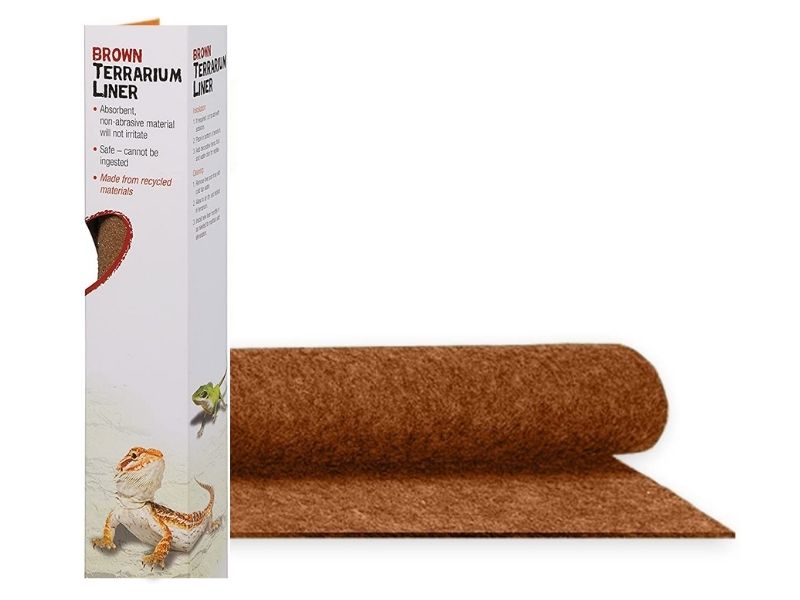
Another one of the best beddings for a leopard gecko is the Zilla Reptile Terrarium Bedding Substrate Liner, Brown, 40BR/50G. This is a substrate with little to no clay content and is made up of peat moss that’s been sterilized for your gecko’s safety.
This bedding provides plenty of air pockets which are also moisture-resistant and soaks up liquid like a sponge while providing excellent drainage as well. It will help keep your gecko dry in both moist or arid environments, unlike other substrates which may do one better than the others but not excel at both equally.
The bedding looks very natural thanks to its brown coloration and there should be minimal risk of impaction due to it being non-abrasive on teeth or claws.
The good
- Safe for the leopard gecko as it can’t be swallowed.
- Easy to clean even with cold tap water.
- Has been treated to eliminate any odors in it.
- The substrate is non-abrasive and absorbent and therefore doesn’t hurt the pet.
The not-so-good
- Can quickly soak up poop smell if not cleaned frequently enough.
While this substrate works great for your leopard geckos, I wouldn’t recommend it for other pets especially bearded dragons.
3. BioDudes Bioactive Substrate for Reptiles
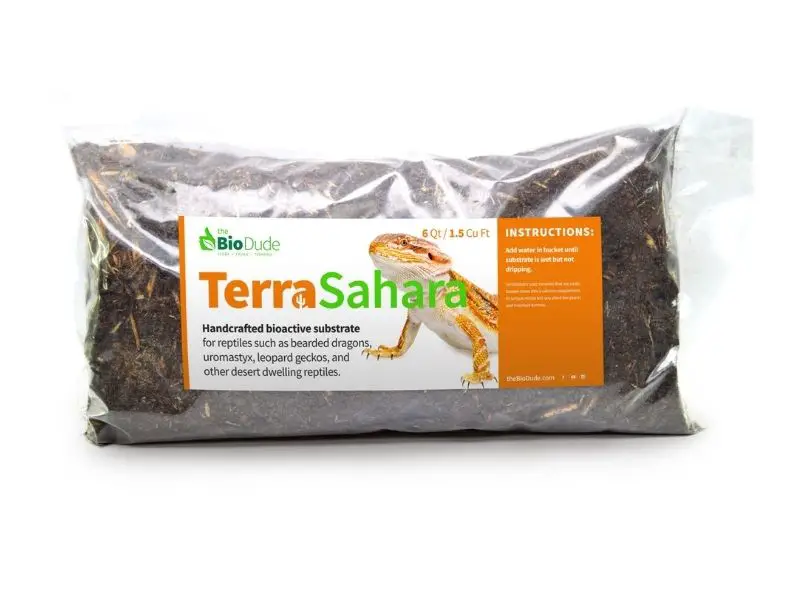
This BioDudes Bioactive Substrate for Reptiles is a perfect substrate for your leopard geckos it contains no chemical additives and it’s non-toxic, odorless, dust-free, and easy to clean up.
It will not grow mold or mildew in your vivarium because the BioDudes Bioactive Substrates are made of natural materials such as Gypsum (calcium sulfate), Montmorillonite Clay (a type of clay with properties that bind nutrients) and Dolomitic Lime (magnesium calcium carbonate).
This BioDudes Bioactive Substrate for Reptiles has been scientifically tested on live animals in laboratories so you can know what you’re giving your leopard geckos or other reptiles is safe and healthy.
The good
- Has the perfect moisture level for leopard geckos because its substrate that has a high water-holding capacity, unlike sand which holds little to no water at all.
- Has a soil-like in texture so your gecko can burrow deeply down into them if they want to as well.
- Safe since it provides enough space between pieces of dirt or rocks so you don’t risk impaction from swallowing larger particles of substrate.
- Safe as it won’t affect their diet by changing pH levels too much like some other substrates do.
This Bioactive substrate makes great gecko bedding as it closely mimics the natural conditions of the floor of your leopard gecko.
4. A DIY Blended Substrate
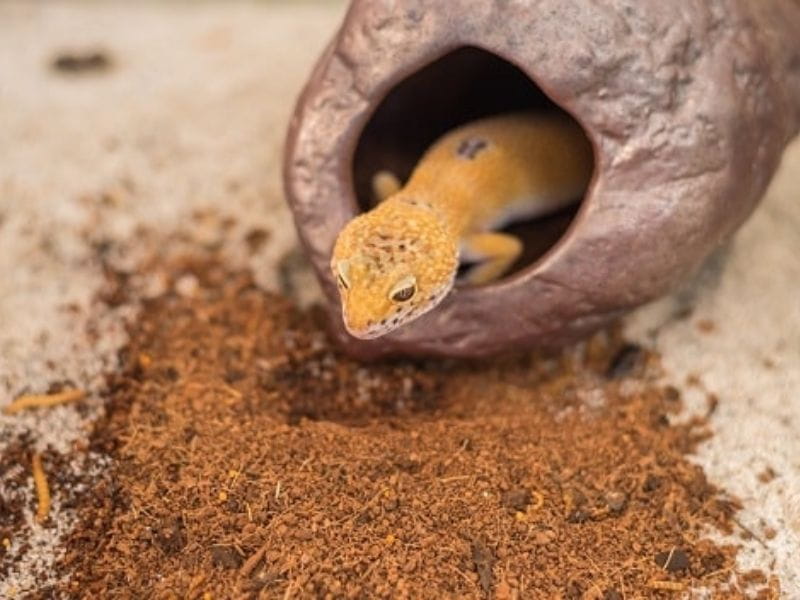
You can, luckily, make your own substrate right at home if the other options on this list are too costly or don’t meet your needs.
For the best leopard gecko flooring, mix organic top soil, play sand and clay in the ratio 5:3:2. Make sure the soils chosen have no pesticides or fertilizers as these might be irritating to the leopard gecko(s).
After preparing this substrate, leave it in the gecko’s tank for at least 1 or 2 weeks before introducing your gecko to the cage. This is enough time for the substrate to adjust to the ambient temperatures of your household. It’s also a good time to observe the substrate as it dries up.
You only need to replace this substrate once every year to prevent the accumulation of bacteria and other pathogens. It’s a cheap and reliable substrate.
The good
- Affordable compared to the commercial options.
- Works with lots of reptiles owing to being safe for a majority of them.
- Less maintenance required as it needs little changing and cleaning.
There’s not much in the negatives for this substrate apart from requiring that you mix it correctly lest it doesn’t provide the needed living conditions for your pet lizard.
READ ALSO: A Guide to Dented Leopard Gecko Eggs – Can They Hatch?
5. Newspapers
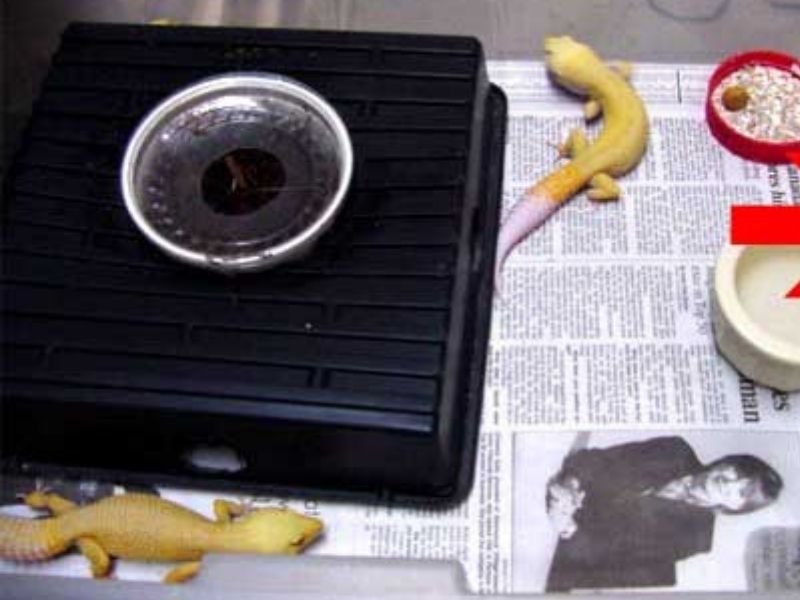
Newspapers can also be used as a substrate for leopard geckos. The more natural the material is, the better it will be. Since newspapers are made from wood, they’re natural.
When using newspapers as a substrate for your leopard geckos, change it out every few days or after a major poop event. Each week, make sure you have changed the newspapers at least once or twice to prevent the accumulation of germs.
It’s not all rosy for newspapers as a substrate for your leopard geckos. Newspapers are to be avoided because, at times, they contain toxic chemicals which can cause death in some animals and reptiles. It’s the reason they shouldn’t be in the gecko’s cage for too long.
The good
- They’re easily available.
- No preparation needed before use.
The not-so-good
- Can have some chemicals in some cases.
- Need frequent changing of at least once a week.
Newspapers are an easy solution to providing your leopard geckos with a good substrate.
6. Lugarti’s Natural Reptile Bedding

One of the best substrates for leopard geckos is the product Lugarti’s Natural Reptile Bedding. It has a more natural look, and has the added benefit of being 100% safe for reptiles. It also makes cleaning their cage much easier than with other types of substrates.
This substrate does not contain any harmful substances or ingredients that could harm your gecko and can be used by people who live in an area where there are high levels of humidity. This is one less thing you have to worry about when using these products as bedding material for leopard geckos.
The maintenance for this substrate is also quite easy. It can be vacuumed, and spot cleaned with a cloth or paper towel.
The good
- 100% safe for reptiles.
- Has a more natural look than other substrates.
- Easier cleaning process than with other types of bedding materials.
- Allows the animals to burrow naturally as it is in nature.
- Grows live plants.
- Doesn’t cause impaction.
This is definitely the best substrate for leopard geckos if you are looking to go for something more natural that will not harm your pets. It’s the best leopard gecko sand that won’t cause impaction in your pets.
7. Reptile Carpet
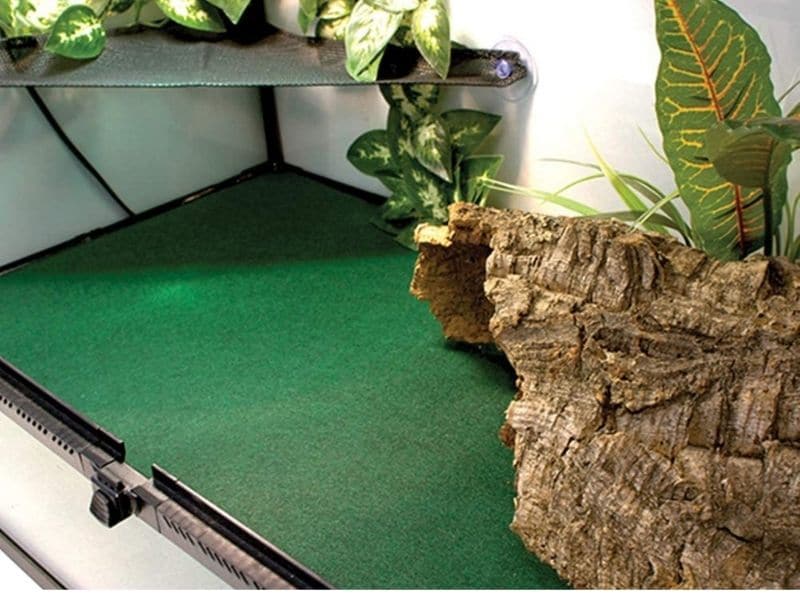
You can also use a reptile carpet as substrate for leopard geckos. Make sure that the carpet is made of material resistant to stains, mold and mildew such as cotton or polyester. The edges need to be finished with an adequate border so it doesn’t unravel from being walked on by your pets.
Reptile carpets for leopard geckos are a good choice because they are easy to clean and maintain. You can simply vacuum them with your regular household cleaner, or spot clean by using warm water mixed with mild soap on the affected area.
Remember that it’s essential for you to replace the carpet every one to two years so your gecko will have some variety in its habitat from time to time.
Reptile carpets also provide security and protection against any sharp objects like rocks, branches etc., which may harm your leopard gecko if used as substrate instead of reptile carpeting.
If your reptile is an active burrower, then this option might not be a good idea since it doesn’t offer many hiding places for their prey items such as mealworms and crickets.
For the best experience with this one, you need to have at least two carpets such that one will be in the washing machine while the other one is being used by the leopard geckos.
The good
- Easy to clean as a washing machine can be used.
- Doesn’t cause impaction in the geckos.
The not-so-good
- Doesn’t allow burrowing.
- You need to buy at least two of them to allow washing.
- Needs to be totally replaced by the 5th wash or the second year in use.
- Changing the carpet can be hard especially when the gecko’s cage has lots of items in it.
If you’re okay with changing the cage every few weeks, go for this one as it needs little maintenance on your end.
If you’re wondering what substrate is best for leopard geckos from the list above, the choice is entirely yours. It depends on aspects such as the gecko breed you have, the size of the cage, and others. You have the choice between gecko sand or other substrates.
What should I NOT use as a leopard gecko substrate?
Some of the items to avoid when choosing a substrate for your leopard gecko include the following:
- Shelf liner
- Aspen chips
- Ground walnut shells
- Linoleum
- Coconut fiber
These substrates, while offered as options for your leopard gecko, should be avoided as they pose more risks to the gecko than the benefits they come with.
Impaction in leopard geckos and how to prevent it
Impaction refers to the intestines (or other organs) getting stuck and unable to pass through the body’s opening. Leopard geckos are one of the most popular pets in homes, which is why it’s important to understand how impaction may happen so that you can prevent it.
Here are some common causes for impaction:
- Incorrect diet
Your leopard gecko needs a mix of protein sources including insects such as mealworms or crickets. In addition, they need a variety of vegetables like carrots, broccoli, squash etc. Basically, anything green.
Don’t feed them too much fruit either because this will cause diarrhoea. Feeding just lives food also increases risk of impactions since animals with hard exoskeletons can get stuck in their digestive tracts.
- Bad substrate
Using a substrate like sand in an enclosure creates the risk of impaction because it gets stuck in the gecko’s nose, mouth and other crevices where they may get grain or two inside them.
- Stress
Leopard geckos are more likely to eat their faeces when stressed which can lead to an impaction if it isn’t removed from the body before passing through. Remember that any change in diet, stressor (such as new animals) or temperature can make your pet susceptible to this problem.
Though you might not think so at first glance – overcrowding is another cause for impactions. A leopard gecko having tank mates will increase competition and fighting over food sources leading to less eating without enough time between meals for digestion.
Using the right substrate is among the ways you can prevent impaction in your geckos. Without intervention, impaction can easily kill your beloved leopard geckos.
READ NEXT: Best Foods to Feed Leopard Geckos
